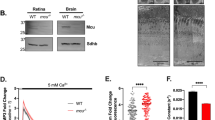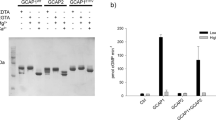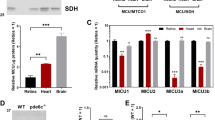Abstract
This study with recombinant reconstituted system mimicking the cellular conditions of the native cones documents that photoreceptor ROS-GC1 is modulated by gaseous CO2. Mechanistically, CO2 is sensed by carbonic anhydrase (CAII), generates bicarbonate that, in turn, directly targets the core catalytic domain of ROS-GC1, and activates it to increased synthesis of cyclic GMP. This, then, functions as a second messenger for the cone phototransduction. The study demonstrates that, in contrast to the Ca2+-modulated phototransduction, the CO2 pathway is Ca2+-independent, yet is linked with it and synergizes it. It, through R787C mutation in the third heptad of the signal helix domain of ROS-GC1, affects cone-rod dystrophy, CORD6. CORD6 is caused firstly by lowered basal and GCAP1-dependent ROS-GC1 activity and secondly, by a shift in Ca2+ sensitivity of the ROS-GC1/GCAP1 complex that remains active in darkness. Remarkably, the first but not the second defect disappears with bicarbonate thus explaining the basis for CORD6 pathological severity. Because cones, but not rods, express CAII, the excessive synthesis of cyclic GMP would be most acute in cones.










Similar content being viewed by others
References
Duda T, Venkataraman V, Krishnan A, Sharma RK (1998) Rod outer segment membrane guanylate cyclase type 1 (ROS-GC1) gene: structure, organization and regulation by phorbol ester, a protein kinase C activator. Mol Cell Biochem 189:63–70
Johnston JP, Farhangfar F, Aparicio JG, Nam SH, Applebury ML (1997) The bovine guanylate cyclase GC-E gene and 5′ flanking region. Gene 193:219–227
Yang RB, Fulle HJ, Garbers DL (1996) Chromosomal localization and genomic organization of genes encoding guanylyl cyclase receptors expressed in olfactory sensory neurons and retina. Genomics 31:367–372
Goraczniak RM, Duda T, Sitaramayya A, Sharma RK (1994) Structural and functional characterization of the rod outer segment membrane guanylate cyclase. Biochem J 302(Pt 2):455–461
Duda T, Goraczniak R, Surgucheva I, Rudnicka-Nawrot M, Gorczyca WA, Palczewski K, Sitaramayya A, Baehr W, Sharma RK (1996) Calcium modulation of bovine photoreceptor guanylate cyclase. Biochemistry 35:8478–8482
Sharma RK, Duda T, Makino CL (2016) Integrative signaling networks of membrane guanylate cyclases: biochemistry and physiology. Front Mol Neurosci 9:83
Hwang JY, Lange C, Helten A, Hoppner-Heitmann D, Duda T, Sharma RK, Koch KW (2003) Regulatory modes of rod outer segment membrane guanylate cyclase differ in catalytic efficiency and Ca(2+)-sensitivity. Eur J Biochem 270:3814–3821
Helten A, Saftel W, Koch KW (2007) Expression level and activity profile of membrane bound guanylate cyclase type 2 in rod outer segments. J Neurochem 103:1439–1446
Goraczniak R, Duda T, Sharma RK (1997) Structural and functional characterization of a second subfamily member of the calcium-modulated bovine rod outer segment membrane guanylate cyclase, ROS-GC2. Biochem Biophys Res Commun 234:666–670
Lowe DG, Dizhoor AM, Liu K, Gu Q, Spencer M, Laura R, Lu L, Hurley JB (1995) Cloning and expression of a second photoreceptor-specific membrane retina guanylyl cyclase (RetGC), RetGC-2. Proc Natl Acad Sci USA 92:5535–5539
Fulle HJ, Vassar R, Foster DC, Yang RB, Axel R, Garbers DL (1995) A receptor guanylyl cyclase expressed specifically in olfactory sensory neurons. Proc Natl Acad Sci USA 92:3571–3575
Koch KW, Dell’Orco D (2015) Protein and signaling networks in vertebrate photoreceptor cells. Front Mol Neurosci 8:67
Sharma RK, Duda T (2012) Ca(2+)-sensors and ROS-GC: interlocked sensory transduction elements: a review. Front Mol Neurosci 5:42
Arshavsky VY, Burns ME (2012) Photoreceptor signaling: supporting vision across a wide range of light intensities. J Biol Chem 287:1620–1626
Pugh EN Jr, Duda T, Sitaramayya A, Sharma RK (1997) Photoreceptor guanylate cyclases: a review. Biosci Rep 17:429–473
Woodruff ML, Sampath AP, Matthews HR, Krasnoperova NV, Lem J, Fain GL (2002) Measurement of cytoplasmic calcium concentration in the rods of wild-type and transducin knock-out mice. J Physiol 542:843–854
Nakatani K, Chen C, Yau KW, Koutalos Y (2002) Calcium and phototransduction. Adv Exp Med Biol 514:1–20
Duda T, Pertzev A, Sharma RK (2011) 657WTAPELL663 motif of the photoreceptor ROS-GC1: a general phototransduction switch. Biochem Biophys Res Commun 408:236–241
Yoshida S, Yamaji Y, Yoshida A, Kuwahara R, Yamamoto K, Kubata T, Ishibashi T (2006) Novel triple missense mutations of GUCY2D gene in Japanese family with cone-rod dystrophy: possible use of genotyping microarray. Mol Vis 12:1558–1564
Perrault I, Rozet JM, Calvas P, Gerber S, Camuzat A, Dollfus H, Chatelin S, Souied E, Ghazi I, Leowski C, Bonnemaison M, Le Paslier D, Frezal J, Dufier JL, Pittler S, Munnich A, Kaplan J (1996) Retinal-specific guanylate cyclase gene mutations in Leber’s congenital amaurosis. Nat Genet 14:461–464
Perrault I. Rozet JM, Gerber S, Ghazi I, Leowski C, Ducroq D, Souied E, Dufier JL, Munnich A, Kaplan J (1999) Leber congenital amaurosis. Mol Genet Metab 68:200–208
Rozet JM, Perrault I, Gerber S, Hanein S, Barbet F, Ducroq D, Souied E, Munnich A, Kaplan J (2001) Complete abolition of the retinal-specific guanylyl cyclase (retGC-1) catalytic ability consistently leads to leber congenital amaurosis (LCA). Invest Ophthalmol Vis Sci 42:1190–1192
Kelsell RE, Gregory-Evans K, Payne AM, Perrault I, Kaplan J, Yang RB, Garbers DL, Bird AC, Moore AT, Hunt DM (1998) Mutations in the retinal guanylate cyclase (RETGC-1) gene in dominant cone-rod dystrophy. Hum Mol Genet 7:1179–1184
Hunt DM, Buch P, Michaelides M (2010) Guanylate cyclases and associated activator proteins in retinal disease. Mol Cell Biochem 334:157–168
Duda T, Venkataraman V, Goraczniak R, Lange C, Koch KW, Sharma RK (1999) Functional consequences of a rod outer segment membrane guanylate cyclase (ROS-GC1) gene mutation linked with Leber’s congenital amaurosis. Biochemistry 38:509–515
Duda T, Krishnan A, Venkataraman V, Lange C, Koch KW, Sharma RK (1999) Mutations in the rod outer segment membrane guanylate cyclase in a cone-rod dystrophy cause defects in calcium signaling. Biochemistry 38:13912–13919
Duda T, Venkataraman V, Jankowska A, Lange C, Koch KW, Sharma RK (2000) Impairment of the rod outer segment membrane guanylate cyclase dimerization in a cone-rod dystrophy results in defective calcium signaling. Biochemistry 39:12522–12533
Wilkie SE, Newbold RJ, Deery E, Walker CE, Stinton I, Ramamurthy V, Hurley JB, Bhattacharya SS, Warren MJ, Hunt DM (2000) Functional characterization of missense mutations at codon 838 in retinal guanylate cyclase correlates with disease severity in patients with autosomal dominant cone-rod dystrophy. Hum Mol Genet 9:3065–3073
Sambrook J, Fritsch EF, Maniatis T (1989) “Expression of cloned genes in cultured mammalian cells” in: a laboratory manual, 2nd edn. Cold Spring Harbor Laboratory, Cold Spring Harbor, pp 16.11–16.81
Duda T, Pertzev A, Makino CL, Sharma RK (2016) Bicarbonate and Ca(2+) sensing modulators activate photoreceptor ROS-GC1 synergistically. Front Mol Neurosci 9:5
Duda T, Pertzev A, Sharma RK (2012) Differential Ca(2+) sensor guanylate cyclase activating protein modes of photoreceptor rod outer segment membrane guanylate cyclase signaling. Biochemistry 51:4650–4657
Nambi P, Aiyar NV, Sharma RK (1982) Adrenocorticotropin-dependent particulate guanylate cyclase in rat adrenal and adrenocortical carcinoma: comparison of its properties with soluble guanylate cyclase and its relationship with ACTH-induced steroidogenesis. Arch Biochem Biophys 217:638–646
Duda T, Wen XH, Isayama T, Sharma RK, Makino CL (2015) Bicarbonate modulates photoreceptor guanylate cyclase (ROS-GC) catalytic activity. J Biol Chem 290:11052–11060
Makino CL, Pertzev A, Sharma RK, Duda T (2017) Bicarbonate enters a rod thru its sysnapse to stimulate ROS-GC in its outer segment, where as cones generate bicarbonate intracellularly from CO2. IOVS 58:1027
Nork TM, McCormick SA, Chao GM, Odom JV (1990) Distribution of carbonic anhydrase among human photoreceptors. Invest Ophthalmol Vis Sci 31:1451–1458
Brooks MJ, Rajasimha HK, Roger JE, Swaroop A (2011) Next-generation sequencing facilitates quantitative analysis of wild-type and Nrl(−/−) retinal transcriptomes. Mol Vis 17:3034–3054
Sharon D, Wimberg H, Kinarty Y, Koch KW (2017) Genotype-functional-phenotype correlations in photoreceptor guanylate cyclase (GC-E) encoded by GUCY2D. Prog Retin Eye Res. https://doi.org/10.1016/j.preteyeres.2017.10.003
Zagel P, Dell’Orco D, Koch KW (2013) The dimerization domain in outer segment guanylate cyclase is a Ca(2)(+)-sensitive control switch module. Biochemistry 52:5065–5074
Ravichandran S, Duda T, Pertzev A, Sharma RK (2017) Membrane guanylate cyclase catalytic subdomain: structure and linkage with calcium sensors and bicarbonate. Front Mol Neurosci 10:173
Lange C, Duda T, Beyermann M, Sharma RK, Koch KW (1999) Regions in vertebrate photoreceptor guanylyl cyclase ROS-GC1 involved in Ca(2+)-dependent regulation by guanylyl cyclase-activating protein GCAP-1. FEBS Lett 460:27–31
Pertzev A, Duda T, Sharma RK (2010) Ca(2+) sensor GCAP1: a constitutive element of the ONE-GC-modulated odorant signal transduction pathway. Biochemistry 49:7303–7313
Hu J, Zhong C, Ding C, Chi Q, Walz A, Mombaerts P, Matsunami H, Luo M (2007) Detection of near-atmospheric concentrations of CO2 by an olfactory subsystem in the mouse. Science 317:953–957
Juilfs DM, Fulle HJ, Zhao AZ, Houslay MD, Garbers DL, Beavo JA (1997) A subset of olfactory neurons that selectively express cGMP-stimulated phosphodiesterase (PDE2) and guanylyl cyclase-D define a unique olfactory signal transduction pathway. Proc Natl Acad Sci USA 94:3388–3395
Duda T, Jankowska A, Venkataraman V, Nagele RG, Sharma RK (2001) A novel calcium-regulated membrane guanylate cyclase transduction system in the olfactory neuroepithelium. Biochemistry 40:12067–12077
Torrents D, Suyama M, Zdobnov E, Bork P (2003) A genome-wide survey of human pseudogenes. Genome Res 13:2559–2567
Young JM, Waters H, Dong C, Fulle HJ, Liman ER (2007) Degeneration of the olfactory guanylyl cyclase D gene during primate evolution. PLoS ONE 2:e884
Shusterman D, Avila PC (2003) Real-time monitoring of nasal mucosal pH during carbon dioxide stimulation: implications for stimulus dynamics. Chem Senses 28:595–601
Krishnan A, Goraczniak RM, Duda T, Sharma RK (1998) Third calcium-modulated rod outer segment membrane guanylate cyclase transduction mechanism. Mol Cell Biochem 178:251–259
Koch KW, Duda T, Sharma RK (2010) Ca(2+)-modulated vision-linked ROS-GC guanylate cyclase transduction machinery. Mol Cell Biochem 334:105–115
Koch KW, Dell’orco D (2013) A calcium-relay mechanism in vertebrate phototransduction. ACS Chem Neurosci 4:909–917
Camuzat A, Rozet JM, Dollfus H, Gerber S, Perrault I, Weissenbach J, Munnich A, Kaplan J (1996) Evidence of genetic heterogeneity of Leber’s congenital amaurosis (LCA) and mapping of LCA1 to chromosome 17p13. Hum Genet 97:798–801
Gradstein L, Zolotushko J, Sergeev YV, Lavy I, Narkis G, Perez Y, Guigui S, Sharon D, Banin E, Walter E, Lifshitz T, Birk OS (2016) Novel GUCY2D mutation causes phenotypic variability of Leber congenital amaurosis in a large kindred. BMC Med Genet 17:52
Anantharaman V, Balaji S, Aravind L (2006) The signaling helix: a common functional theme in diverse signaling proteins. Biol Direct 1:25
Garbers DL (1992) Guanylyl cyclase receptors and their endocrine, paracrine, and autocrine ligands. Cell 71:1–4
Wilson EM, Chinkers M (1995) Identification of sequences mediating guanylyl cyclase dimerization. Biochemistry 34:4696–4701
Tucker CL, Woodcock SC, Kelsell RE, Ramamurthy V, Hunt DM, Hurley JB (1999) Biochemical analysis of a dimerization domain mutation in RetGC-1 associated with dominant cone-rod dystrophy. Proc Natl Acad Sci USA 96:9039–9044
Ramamurthy V, Tucker C, Wilkie SE, Daggett V, Hunt DM, Hurley JB (2001) Interactions within the coiled-coil domain of RetGC-1 guanylyl cyclase are optimized for regulation rather than for high affinity. J Biol Chem 276:26218–26229
Peshenko IV, Moiseyev GP, Olshevskaya EV, Dizhoor AM (2004) Factors that determine Ca2+ sensitivity of photoreceptor guanylyl cyclase. Kinetic analysis of the interaction between the Ca2+-bound and the Ca2+-free guanylyl cyclase activating proteins (GCAPs) and recombinant photoreceptor guanylyl cyclase 1 (RetGC-1). Biochemistry 43:13796–13804
Dizhoor AM, Olshevskaya EV, Peshenko IV (2016) The R838S mutation in retinal guanylyl cyclase 1 (RetGC1) alters calcium sensitivity of cGMP synthesis in the retina and causes blindness in transgenic mice. J Biol Chem 291:24504–24516
Hirayama T, Wada A, Hidaka Y, Fujisawa J, Takeda Y, Shimonishi Y (1993) Expression of a truncated guanylate cyclase (GC-C), a receptor for heat-stable enterotoxin of enterotoxigenic Escherichia coli, and its dimer formation in COS-7 cells. Microb Pathog 15:283–291
van den Akker F, Zhang X, Miyagi M, Huo X, Misono KS, Yee VC (2000) Structure of the dimerized hormone-binding domain of a guanylyl-cyclase-coupled receptor. Nature 406:101–104
Saha S, Biswas KH, Kondapalli C, Isloor N, Visweswariah SS (2009) The linker region in receptor guanylyl cyclases is a key regulatory module: mutational analysis of guanylyl cyclase C. J Biol Chem 284:27135–27145
Venkataraman V, Duda T, Ravichandran S, Sharma RK (2008) Neurocalcin delta modulation of ROS-GC1, a new model of Ca(2+) signaling. Biochemistry 47:6590–6601
Rauch A, Leipelt M, Russwurm M, Steegborn C (2008) Crystal structure of the guanylyl cyclase Cya2. Proc Natl Acad Sci USA 105:15720–15725
Winger JA, Derbyshire ER, Lamers MH, Marletta MA, Kuriyan J (2008) The crystal structure of the catalytic domain of a eukaryotic guanylate cyclase. BMC Struct Biol 8:42
Xu J, Morris L, Thapa A, Ma H, Michalakis S, Biel M, Baehr W, Peshenko IV, Dizhoor AM, Ding XQ (2013) cGMP accumulation causes photoreceptor degeneration in CNG channel deficiency: evidence of cGMP cytotoxicity independently of enhanced CNG channel function. J Neurosci 33:14939–14948
Wang T, Tsang SH, Chen J (2017) Two pathways of rod photoreceptor cell death induced by elevated cGMP. Hum Mol Genet 26:2299–2306
Duda T, Pertzev A, Sharma RK (2013) The ANF-RGC gene motif (669)WTAPELL(675) is vital for blood pressure regulation: biochemical mechanism. Biochemistry 52:2337–2347
Duda T, Pertzev A, Sharma RK (2012) Ca(2+) modulation of ANF-RGC: new signaling paradigm interlocked with blood pressure regulation. Biochemistry 51:9394–9405
Duda T, Pertzev A, Sharma RK (2014) Atrial natriuretic factor receptor guanylate cyclase, ANF-RGC, transduces two independent signals, ANF and Ca(2+). Front Mol Neurosci 7:17
Vasques GA, Amano N, Docko AJ, Funari MF, Quedas EP, Nishi MY, Arnhold IJ, Hasegawa T, Jorge AA (2013) Heterozygous mutations in natriuretic peptide receptor-B (NPR2) gene as a cause of short stature in patients initially classified as idiopathic short stature. J Clin Endocrinol Metab 98:E1636–E1644
Nakao K, Osawa K, Yasoda A, Yamanaka S, Fujii T, Kondo E, Koyama N, Kanamoto N, Miura M, Kuwahara K, Akiyama H, Bessho K, Nakao K (2015) The Local CNP/GC-B system in growth plate is responsible for physiological endochondral bone growth. Sci Rep 5:10554
Yasoda A, Nakao K (2010) Translational research of C-type natriuretic peptide (CNP) into skeletal dysplasias. Endocr J 57:659–666
Duda T, Venkataraman V, Krishnan A, Nagele RG, Sharma RK (2001) Negatively calcium-modulated membrane guanylate cyclase signaling system in the rat olfactory bulb. Biochemistry 40:4654–4662
Venkataraman V, Nagele R, Duda T, Sharma RK (2000) Rod outer segment membrane guanylate cyclase type 1-linked stimulatory and inhibitory calcium signaling systems in the pineal gland: biochemical, molecular, and immunohistochemical evidence. Biochemistry 39:6042–6052
Acknowledgements
We thank Dr. Clint Makino, Boston University, for critical review and constructive comments. This work was supported by National Institutes of Health: EY 023980. The authors are solely responsible for the contents of this study, which may not represent the views of the National Institutes of Health and Human Services. There is no mention of trade names, commercial products, of organizations implying endorsement by the US government.
Author information
Authors and Affiliations
Corresponding author
Ethics declarations
Conflict of interest
The authors declare that they do not have any conflict of interest.
Electronic supplementary material
Below is the link to the electronic supplementary material.
Rights and permissions
About this article
Cite this article
Duda, T., Pertzev, A. & Sharma, R.K. CO2/bicarbonate modulates cone photoreceptor ROS-GC1 and restores its CORD6-linked catalytic activity. Mol Cell Biochem 448, 91–105 (2018). https://doi.org/10.1007/s11010-018-3317-9
Received:
Accepted:
Published:
Issue Date:
DOI: https://doi.org/10.1007/s11010-018-3317-9




